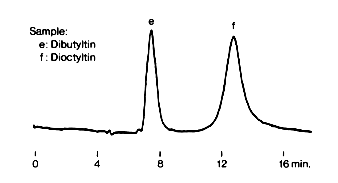Environmental Pollutants
Arsenic compound in marine life were analyzed using Asahipak GS-220 7G (a multimode column).
GS-220 7G is an old type of GS-220 HQ.

Sample : Arsenic compounds
Column : Shodex Asahipak GS-220 7G (7.5mmID*500mm) Eluent : 50mM Sodium phosphate buffer(pH6.8) Flow rate : 1.0mL/min Detector : Atomic absorption detector
M.Morita and Y.Shibata, Anal.Sci., 3 (1987) 575.
RSpak NN-614 is packed with poly(hydroxymethacrylate) bonded with trace amounts of sulfo groups, and the main separation mode is the reversed phase mode. However, due to the sulfo groups, ion interaction also works. Acidic substances are separated by ion exclusion mode and elute faster. Neutral substances are separated by reversed phase and alkaline substances are separated by a mixture of reversed phase (in the case of hydrophobic structure) and ion exchange mode. Therefore, the elution order is basically as follows: first the acidic, then the neutral and finally the alkaline substances. The column is suited to the analysis of mixture of acidic, neutral and alkaline substances.


Sample : Arsenic compounds,(Above) 100ppm each, (Below) 10ppb each, 20micro-L
Monomethylarsonic acid, MMAA
Dimethylarsinic acid, DMAA
Arsenobetaine, AB
Tetramethylarsonium, TeMA
Trimethylarsine oxide, TMAO
(HPLC)
Instrument : Agilent 1100
Column : Shodex RSpak NN-614 (6.0mmID*150mm)
Eluent : 8mM HNO3/5mM NH4NO3 aq.
Flow rate : 0.4mL/min
Column temp. : 40deg-C
(MS)
Instrument : Agilent 1100MSD
Mass range : (Above): TIC 100-1000(m/z)
(Below): SIM
Ionization : Electrospray
Polarity : Positive
Fragmentor : 80V
Nebulizer : N2(60psi)
Drying gas : N2(10L/min, 350deg-C)
RSpak NN-614 is packed with poly(hydroxymethacrylate) bonded with trace amounts of sulfo groups, and the main separation mode is the reversed phase mode. However, due to the sulfo groups, ion interaction also works. Acidic substances are separated by ion exclusion mode and elute faster. Neutral substances are separated by reversed phase and alkaline substances are separated by a mixture of reversed phase (in the case of hydrophobic structure) and ion exchange mode. Therefore, the elution order is basically as follows: first the acidic, then the neutral and finally the alkaline substances. The column is suited to the analysis of mixture of acidic, neutral and alkaline substances.RSpak NN-614 is packed with poly(hydroxymethacrylate) bonded with trace amounts of sulfo groups, and the main separation mode is the reversed phase mode. However, due to the sulfo groups, ion interaction also works. Acidic substances are separated by ion exclusion mode and elute faster. Neutral substances are separated by reversed phase and alkaline substances are separated by a mixture of reversed phase (in the case of hydrophobic structure) and ion exchange mode. Therefore, the elution order is basically as follows: first the acidic, then the neutral and finally the alkaline substances. The column is suited to the analysis of mixture of acidic, neutral and alkaline substances.


Sample : Arsenic compounds, 50micro-L
1. Monomethylarsonic acid, MMAA
2. Arsinic acid, As(III)
3. Dimethylarsinic acid, DMAA
4. Arsenobetaine, AB
5. Tetramethylarsonium, TeMA
6. Trimethylarsine oxide, TMAO
Sample : 10-fold diluted Urine, 50micro-L
*Arsenic acid (As(V)) was detected before MMAA in the urine sample.
(HPLC) Instrument : Agilent IC 7000 Column : Shodex RSpak NN-614 (6.0mmID*150mm) Eluent : 5mM HNO3/8mM NH4NO3 aq. Flow rate : 0.8mL/min (MS) Instrument : Agilent 4500 IC-ICP-MS Mass range : SIM (m/z=75)
(Reference)
Noriko Tsunoda,
Pharmacia. 1998, vol.34, no.12, p.1237-1241.
Dialkyltin compounds were analyzed using Asahipak GS-310 7E (a multimode column).
GS-310 7E is an old type of GF-310 HQ.

Sample :
e. Dibutyltin
f. Dioctyltin
Column : Shodex Asahipak GS-310 7E (7.5mmID*250mm) Eluent : 0.01M KH2PO4 buffer(pH2.0)/CH3OH=40/60 Reagent : 0.005% Morin in CH3OH (for post column reaction) Flow rate : (Eluent); 1.0mL/min, (Reagent); 0.5mL/min Detector : Fluorescence(Ex. 420nm, Em. 500nm)
H.Nakajima et al.,BUNSEKI KAGAKU, 36 (1987) 867
Five kinds of haloacetic acid were analyzed with RSpak JJ-50 2D.

Sample : 500ppm each, 2micro-L
1. Chloroacetic acid
2. Bromoacetic acid
3. Dichloroacetic acid
4. Dibromoacetic acid
5. Trichloroacetic acid
Column : Shodex RSpak JJ-50 2D (2.0mmID*150mm) Eluent : 25mM CH3COONH4 buffer(pH9.2)/CH3CN=50/50 Flow rate : 0.2mL/min Detector : UV(210nm) Column temp. : 40deg-C
Polycyclic Aromatic hydrocarbons (PAHs) such as Benzo[a]pyrene existing in the air are known as the carcinogen or mutagen. Recentry, it developed that Nitro-polycyclic aromatic hydrocarbon (NPAH), which in one of carcinogen, is in also existing in the air. And the carcinogens and mutagens come from diesel dust. The following application data shows that the separation of carcinogens existing in the diesel dust with using GPC clean up column, CLNpak PAE-800 AC column.


Sample :
1. Bisphenol A
2. Benzo[a]fluoranthene
3. 1,3-Dinitropyrene
4. Benzo[a]pyrene
5. Hydroxybenzo[a]pyrene mixture
Column : Shodex CLNpak PAE-800 AC (8.0mmID*300mm) Eluent : Acetone Flow rate : 0.8mL/min Detector : UV(210nm) Column temp. : Room temp.
Courtesy of Dr. Kazuichi Hayakawa, Faculty of Pharmaceutical Science, Kanazawa University
The pretreatment of polychlorinated biphenyls (PCBs) analysis in wate oil was considered using CLNpak PAE-2000 AC.

Sample : PCBs, Polychlorinated biphenyls
Columns : Shodex CLNpak PAE-G (8.0mmID*50mm) + PAE-2000 AC (20.0mmID*300mm) Eluent : Acetone Flow rate : 4.0mL/min Detector : UV(213nm)
Data provided of Mr. Koichi Sasaki, Analytical Center. Kokan Keisoku Corporation.
